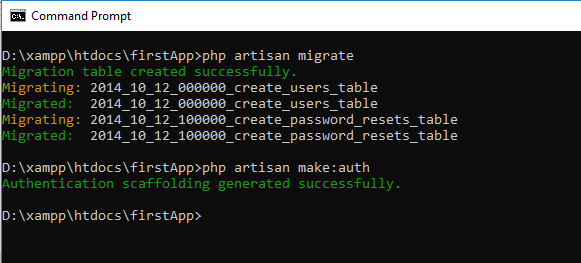Laravel login authentication register with example. In this laravel 5.8 default login authentication system, we will study about how to create laravel login authentication and register with example .Step by Step Guide to Building Your First laravel login authentication and register Laravel 5.8 Application. A complete step by step complete guide.
Laravel 5.8 is recently release with great new features and improvents. We are going to show you how to create login and register auth system using one command name php artisan make:auth. This command will create some default views blade, controllers and routes. that is help to login and register a users.
Contents
- First Install Laravel Fresh Project
- Configuration changes in .env file
- Generate Laravel Application Key
- Database Migration
- Create a Login Authentication Laravel
- Now Run the created project
- Conclusion
1. First Install Laravel Fresh Project
First we have install laravel new setup in our system . where we installed php. open your terminal and type the below command :
composer create-project --prefer-dist laravel/laravel firstApp
Note : In this command firstApp is project folder name
If your using ubuntu machine. open your terminal and go to your project root directory and type the command in command prompt :
sudo chmod -R 777 storage
sudo chmod -R 777 bootstrap
2. Configuration changes in .env file
After successfully installed the laravel application, in the next step is configuration .evn file. Let’s open .env file and setup database credential like database name , database user name , databasse password and host.

3. Generate Laravel Application Key
Configuration compeleted successfully of .evn file , Let’s open the command prompt and generate laravel application key using this given below command.
php artisan key:generate
4. Database Migration
Before you run php artisan migrate command.
Go to the app/providers/AppServiceProvider.php and put the two line of code inside a boot method
Use Schema;
public function boot() {
Schema::defaultStringLength(191);
}
Use this below command , it will automatic created tables in your database. A new migration file is created by you. You update the code in that migration, run php artisan migrate again, and you have a new column in your table.
php artisan migrate

5. Laravel Authentication
This command will create routes , controllers and views files for Laravel Login Authentication and registration. It means provide a basic laravel login authentication and registration Complete system. Let’s open the command propmt and type the below command.
php artisan make:auth

6. Now run the created project
In this step to use the php artisan serve command .it will start your server locally
php artisan serve
If you want to run the project diffrent port so use this command
php artisan serve --port=8080
laravel authentication is successfully completed, Now Go to the browser and hit the
URL : http://localhost:8000/login
If you not run php artisan server command , direct go to your browser and type the url
URL : http://localhost/firstApp/public/
On your browser see this :

Laravel 5.8 Register Screen :

7. Conclusion
We have successfully install laravel 5.8 fresh new application and also created laravel login authentication.
I hope you like it, If you have any questions or thoughts to share, use the comment form below to reach us.